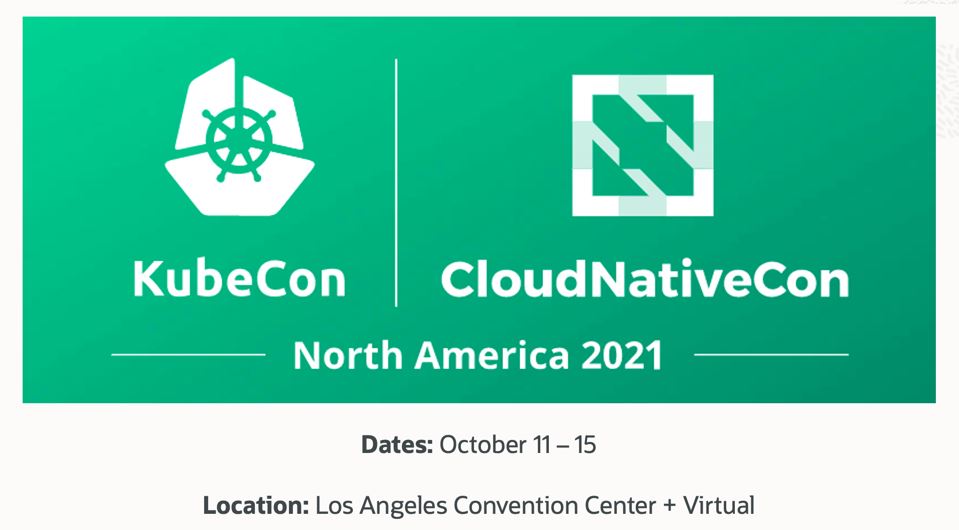
We are excited to be participating in and sponsoring KubeCon + CloudNativeCon 2021 in Los Angeles, California starting next week. The Oracle team will be at the Los Angeles Convention Center in-person (yay!) and virtually at KubeCon + CloudNativeCon. We hope to see you there! This flagship conference from Cloud Native Computing Foundation (CNCF) is a mecca for developers and technologists who are passionate and committed to driving innovation in the open-source community.
At Oracle, we continue to invest and increase our commitment to the open-source community and simplifying cloud native application development. We are a proud Platinum member of CNCF for the last four years. Oracle recently joined the Continuous Delivery Foundation (CDF) to build on our involvement in the Linux Foundation and CNCF and to support the growth of open source. Our Cloud Native services are built on CNCF standards and follow open standards. I would like to take this opportunity to share some of the exciting platform and developer experience enhancements that we have recently announced to help developers build, deploy, and manage standards-based cloud native applications.
Platform Enhancements
Modern Application Development framework
Modern applications are hard to get right. The tools, constraints, and possibilities are changing too fast. Oracle recently created a framework for application development to simplify the architectural decision-making to build and run apps that are highly available, resilient, compliant, and fully secure using a set of design principles and technology recommendations. Our modern application development framework simplifies the architectural decision-making process to help you build and run highly available apps that are resilient to failure, fully secure and compliant, and support DevOps. We’ve crystallized our learning into nine core requirements and 10 design principles that represent our opinionated guidance for building a modern app. Regardless of what an app does functionally, every modern app needs to meet a minimum set of requirements. These core requirements include availability, security and compliance, cost optimization, performance, resiliency, agility, scalability, observability, and portability.
Kubernetes Support for Arm-based Compute Instances
In the summer of 2021, Oracle announced its first Arm-based Ampere A1 Compute platform and added support for Arm-based instances in Oracle Container Engine for Kubernetes (OKE). This allows developers to build and deploy native Arm-based applications as well as X86 based applications in a Kubernetes environment with Oracle Container Engine for Kubernetes (OKE). Adding the Arm architecture support as a target for your deployments doesn’t increase the complexity of your codebase or the deployment artifacts. In fact, you get the choice of using mixed architectures and pick the appropriate CPU architecture for your applications. Oracle Container Image Registry (OCIR) supports multi-architecture images, and this helps to have a unified repository for all your application images. Oracle documentation contains more information about Arm support with OKE.
Verrazzano Enterprise Container Platform
Verrazzano is a general-purpose container platform that developers and DevOps engineers can use to deploy, secure, and manage container workloads, including microservices and traditional applications. The product is developed in open source at https://github.com/verrazzano from a collection of open source components and supports Kubernetes clusters running on-premises or in the cloud. Verrazzano will help improve developer productivity and bring cloud native benefits without any lock-in. It provides a cloud-neutral approach to achieve the same automation, observability, and lifecycle benefits for all your container applications, regardless of where you are deploying your applications on-premises, on Oracle Cloud Infrastructure, or other public clouds. You can learn more about Verrazzano from our documentation.
GraalVM and Micronaut
We have been continuously improving and updating GraalVM keeping cloud native application deployment objectives in mind. For cloud native deployments, minimizing resource usage and enabling scalability are core concerns for teams developing Java applications. GraalVM Native Image is ideal for cloud deployments by compiling applications ahead-of-time into native executables that provide fast startup, low memory requirements, and peak performance with no warmup. One of the easiest ways to build applications with GraalVM Native Image is to use Micronaut, a modern framework for creating lightweight microservice and serverless applications. By performing dependency injection at compile-time, Micronaut is optimized for ahead of time compilation. Both GraalVM and Micronaut are projects in the open source, with development happening on GitHub from a vibrant community of developers. GraalVM Enterprise, which provides improved performance and reduced resource requirements along with 24/7 support, is available from Oracle as part of the Java SE Subscription or at no additional cost when deploying apps on Oracle Cloud Infrastructure (OCI).
Developer Experience Enhancements
Service Operator for Kubernetes
The Oracle Cloud Infrastructure (OCI) Service Operator for Kubernetes is an open source Kubernetes add-on that allows users to manage OCI resources, such as the Autonomous Database service and the MySQL Database service through the Kubernetes API. OCI Service Operator for Kubernetes is based on the Operator Framework, an open-source tool used to manage operators. It uses the Kubernetes controller-runtime library, which the Operator SDK uses to provide high-level APIs and abstractions to write operational logic and provides tools for scaffolding and code generation. This Operator for Kubernetes makes it easy to create, manage, and connect to OCI resources from a Kubernetes environment and using standard Kubernetes tooling. The Operator can be used on Kubernetes clusters running on OCI Container Engine for Kubernetes (OKE) or outside OCI. You can learn more about how to get started installing and using this Operator from the Adding OCI Service Operator for Kubernetes to Clusters documentation and from our page on GitHub.
Node Doctor for Oracle Kubernetes Engine (OKE)
We recently announced the availability of Node Doctor, an OCI Container Engine for Kubernetes (OKE) worker node troubleshooting tool. Node Doctor comes pre-installed on all OKE worker nodes and helps with the detection of common node problems. Node Doctor helps you troubleshoot common infrastructure level issues with your OKE cluster worker nodes. For example, when the status of Kubernetes Node Condition is not “Active” or Node State is not “Ready”, Node Doctor provides insights on the underlying problems so you can get your nodes back online. It can also be used to capture helpful data to share with Oracle Support. Node Doctor focuses on common issues related to the intersection between Kubernetes and Oracle Cloud Infrastructure (OCI), the majority of which impact the health of Kubernetes worker nodes. Node Doctor runs several checks to ensure a worker node is operating as intended. For example, Node Doctor can be used to indicate if the number of pods on a node is too high causing issues in the kubelet, the primary node agent running on each worker node, or if a node is running a known bad version of a dependency, such as runC, and should be recycled.
Functions Image Signing and Scanning
Oracle Kubernetes Engine already supported container Image Signing and Scanning to improve the security posture of cloud native applications. We recently added the support for Image Signing and Image Scanning to Oracle Functions. Signing ensures the use of trusted images, free from unauthorized alterations, and scanning provides visibility into potential vulnerabilities inside images. Together these features improve the overall security posture of serverless applications. Oracle Functions is a serverless Functions-as-a-Service platform that lets you create, run, and scale business logic without managing any infrastructure. Functions are created using container images and run as docker containers. Oracle Functions is secure by design and hence, image security is of paramount importance to Functions. You can learn more about Function Image Signing and Scanning from this blog.
If you are attending KubeCon + Cloud NativeCon come and check us out. We have a lot of exciting things to share and some cool swag to give away in our physical booth (Booth S80) so swing by and talk with our team. If you are joining virtually, make sure to check out our online booth here (registered users can log in next week). Here are some of the must-attend sessions:
| Session Name |
Date / Time (US PT) |
| Oracle Kubernetes Engine Enhancements to run large scale secure containerized applications |
10/13/21 11:00 AM |
| Verrazzano – Enterprise Container Platform from Oracle |
10/13/21 12:00 PM |
| Learn how to deploy trusted applications on your Kubernetes cluster |
10/13/21 01:00 PM |
| Automate software deployments using OCI DevOps service |
10/14/21 02:00 PM |
| Using Service Connector to move data across application components |
10/14/21 03:00 PM |
| Verrazzano – Enterprise Container Platform from Oracle |
10/15/21 12:00 PM |
| Cloud Native Enables the Park of Pompeii to Reopen During the Pandemic |
10/15/21 02:30 PM |
PS: We will update this blog and add videos (URLs) for the above sessions soon after the event.
We hope to see you there!
- Team Oracle
